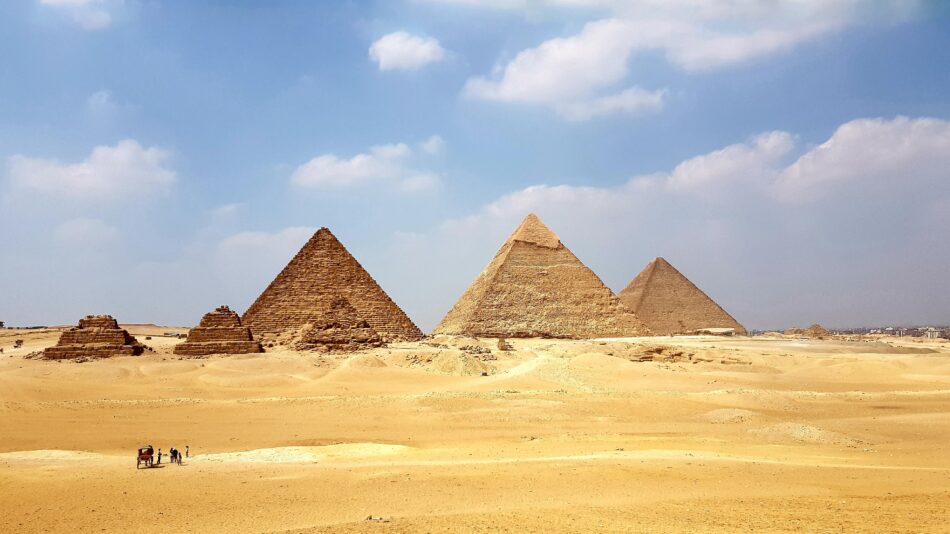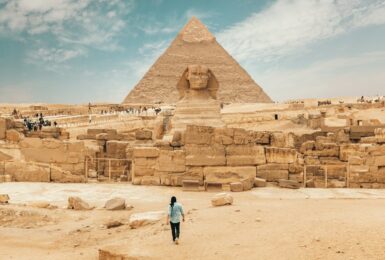 Photo: Contiki
Photo: Contiki
Despite our modern technology and the research of our brilliant modern minds, there are still several great unsolved mysteries in the world. The KFC recipe, the Loch Ness Monster, and the Bermuda Trinagle all rank near the top, but the Great Pyramids of Giza definitely take the cake as the biggest mystery of them all.
How the hell were the Egyptian pyramids built, you wonder? We’re all scratching our heads on this one, but keep reading to get acquainted with some of the most popular theories out there.
First, some history
The Egyptian pyramids of Giza are some of the most impressive man made structures in history, hands down; it makes sense that they’re part of the Seven Wonders of the World.
It’s estimated that they were built over 4,500 years ago with over 2 million stones, and took 20 to 30 years to make. Why were they built you ask? Our Trip Manager on our Egypt and the Nile trip, Sheriff, has this historical tidbit to add: “Ancient Egyptians used to believe in the sun god Raa, and in an effort to reach him before the after life, they came up with the idea of building a structure which would connect the Earth to the Sun. These were the pyramids.”
That’s a pretty cool backstory, but how on earth did they actually do it? It’s a secret that we’ll sadly never uncover. There’s no evidence, no ancient plans, no concrete proof at all, so it’s not surprise that there’s also no shortage of conspiracy theories.
So, we’ve donned our historian hats and done some digging (and we also got our local guide Sheriff to help).

Image source:Osama Elsayed / unsplash
The Ramp Theory
The Ramp Theory, is probably the most popularly accepted theory as to how the Great Pyramids were built, and it has the most evidence to back it up.
In a nutshell, the idea is that the Pyramids were built through the sheer (and impressive) force of tens of thousands of workers. Stones were supposedly pulled across the desert with ropes and sleds, and recent intel tells us that the sand was wet to reduce any friction. This practice can actually be seen depicted in ancient wall paintings! How’s that for proof?
Once the stones were dragged across the desert, the stones were pushed up a series of ramps, which Sheriff confirms were made of either tree trunks or sand, as they built upwards. Talk about a workout, we’re sweating just thinking about it. Levers were also supposedly used once a significant height was reached and ramps were no longer feasible.
This theory is supported by the fact that sleds are well documented in ancient wall paintings, as are images of giant statues being pulled by hundreds of men. These ramps would have however been very time-consuming to construct.
The Water Shaft Theory
The Water Shaft Theory (WST) differs from the Ramp Theory completely, starting with how the stones were transported. Sheriff seems to be a believer in this theory as well as he told us the following:
“The huge blocks of stone used to construct the pyramids were transported on floating rafts along the Nile during the flood season, which lasts for 4 months every year.” The WST highlights that special canals were dug up from the rock quarries to the building sites, drawing water from the Nile, so that the stones could float all the way there, requiring less strength. These canals were built all around the site’s perimeter, allowing blocks to float to the side where they were needed.
What’s great about the WST (if it’s true) is that the floats would double as sleds to pull the stones the rest of the way to the building sites. The floats were supposedly made of cedar wood or inflated animal skins wrapped in papyrus – who knew that was a thing!
A series of gates controlled how the blocks moved upward from the moat to the top, and a pool of water on the top of the build site allowed for further floating and positioning without any dragging or real heavy lifting.
In this theory, these canals and water elevators allowed the stones to be moved pretty easily. Although there is no concrete documented evidence of this theory, traces of water throughout the structure and imperfections along the middle of all four sides have been identified to support the WST.

Image source:Contiki
Making the blocks
There’s no real consensus on how the blocks were made either, though Sheriff has come in clutch with some interesting information. “The Ancient Egyptians chose the build sites for each pyramid in a way that would allow them to be close to quarries. The stone blocks were made of limestone, crystalline, and granite.”
The WST has its own theory on block creation: copper chisels or saws were used to cut the limestone, but the creation of precise cuts and angles without modern technology could have been done in a few ways. Some (WST supporters) say Egyptians used the surface of the water as a level and worked on the stone underwater, making it easier to manipulate. Others cite the use of simple tools such as wooden levels, paint and string to measure the angles and detect spots that weren’t level.
Other Theories
Although the above are the most widely accepted theories, there are some intriguing alternatives floating around as well. Extraterrestrials, long lost technologies, time travel, to name a few.
Regardless of what you believe, there’s no arguing that the Great Pyramids of Giza are ridiculously impressive for the time period, and, sadly, we’ll probably never get a concrete answer as to how they were built. What we can agree on, though, is that it took an insane amount of intelligence and manpower and that we’re so fortunate to have them still standing after all these years.
For now, we’ll continue to listen to the newest theories, marvel over the pyramids themselves and keep them on the top of our travel bucket lists indefinitely.











